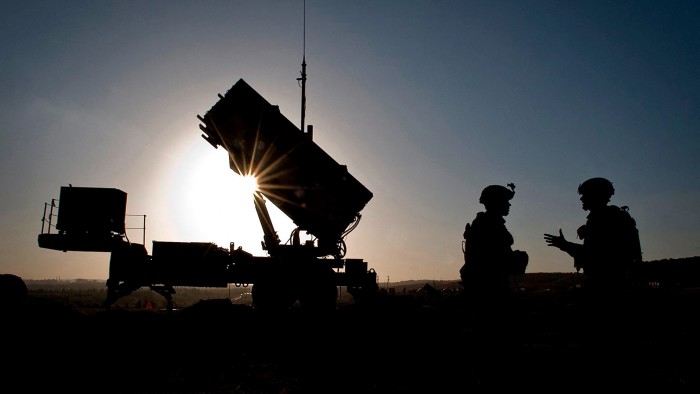Unlock the White House Watch newsletter for free
Your guide to what Trump’s second term means for Washington, business and the world
Ukraine summoned a top diplomat from the US embassy on Wednesday after the White House abruptly halted shipments of several high-value weapons to the country, raising concerns about Kyiv’s defensive posture as Moscow’s summer offensive gains ground.
Ukraine’s foreign minister Andriy Sybiha called the US embassy’s deputy chief of mission in Ukraine, John Ginkel, to the ministry of foreign affairs in Kyiv to discuss military assistance and defence co-operation, according to a statement shared with the Financial Times.
‘‘Any delay or hesitation in supporting Ukraine’s defence capabilities only encourages the aggressor to continue the war and acts of terror, rather than seek peace,” the statement said.
The weapons affected include dozens of PAC-3 interceptors for Patriot air defence systems, dozens of Stinger man-portable air defence systems, precision-guided artillery shells, more than 100 Hellfire missiles and AIM missiles launched by Ukraine’s NASAMS and F-16 fighter jets, according to senior US officials.
The move was driven by concerns over Washington’s own military readiness with stockpiles running too low, they said.
Washington’s decision will send a chill across Ukraine, as it relies on the arms for air defence and frontline support. It comes three days after Russia’s largest missile and drone bombardment on Ukraine since the start of its full-scale invasion, which has further dimmed faint hopes of an end to the war.
‘‘We counted on many of those systems as they were promised,” said a Ukrainian official involved with the country’s military strategy, adding that it would expose civilian infrastructure to attack. “That significantly affects our planning.”
Anti-tank systems such as the AT4 grenade launcher have also been affected, while some of the 250 Guided Multiple Launch Rocket System (GMLRS) rounds used to strike ground targets accurately at long distances have been held up.
“This decision was made to put America’s interests first, following a Department of Defense review of our nation’s military support and assistance to other countries around the globe,” said White House spokesperson Anna Kelly.
The White House declined to confirm the specific weapons systems that were stopped.
“Our commitment [to Ukraine] hasn’t changed,” said Tammy Bruce, state department spokeswoman. “[But] the nature of how we’re able to make that commitment is going to be based on what is best for America First.”
The Pentagon was still offering options for aiding Ukraine militarily but was “examining and adapting its approach”, said Elbridge Colby, Pentagon under-secretary of defence for policy. Colby dismissed criticism of the move as an attempt to “portray division [within the Pentagon] that does not exist”.
Ukraine’s defence ministry said it was clarifying the status of shipments but had not been officially notified about suspensions or changes to previously agreed military assistance.
Politico earlier reported the halt of some weapons to Ukraine.
The decision to withhold the weapons came in early June but was just now coming into force, a person familiar with the matter said. Some shipments were already en route to Ukraine when they were halted, according to the person.
The Kremlin welcomed the US decision. “The less weaponry is supplied to Ukraine, the sooner the [invasion] will end,” spokesman Dmitry Peskov told reporters, according to Interfax.
Russia has enhanced its Iranian-style attack drones in recent months, enabling them to strike with greater speed and lethality. It has also increased the frequency and size of its air attacks and can now attack Ukraine in a day with as many drones as it did in a month a year ago, Kyiv’s air force data shows.
“The absence of Patriot anti-aircraft missiles will lead to an increase in successful Russian missile strikes on Ukrainian cities, which will lead to an increase in civilian casualties,’’ said Viktor Kevlyuk, a military expert at the Kyiv-based Centre for Defence Strategies. ‘‘The absence of GMLRS missiles will limit the ability to deliver missile strikes on targets in the operational depth.”
European and Asian sources could compensate for some of the reductions, but it would be harder for Ukraine’s army in the meantime, he said.
US President Donald Trump has long urged Russia and Ukraine to negotiate a ceasefire and end a war that began with Moscow’s annexation of Crimea in 2014 before the Kremlin’s full-scale invasion in 2022.
Russian President Vladimir Putin appears confident that his army can continue pounding Ukraine from the air and advancing on the battlefield at its fastest pace since November.
‘‘Decisions to withhold critical aid from Ukraine are not likely to bring about President Trump’s desired ceasefire,” said George Barros, an analyst focused on the conflict for the Institute for the Study of War, a Washington-based think-tank.
